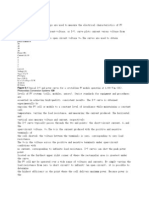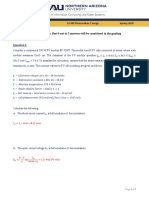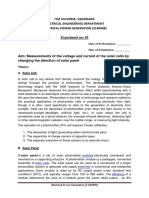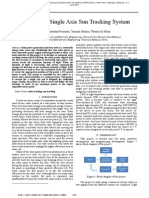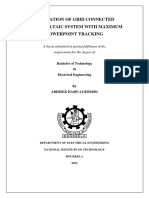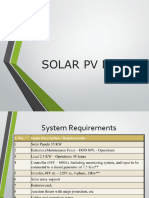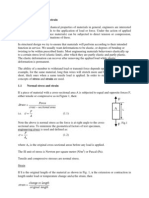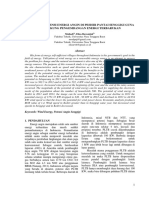Problems: Photovoltaics: EUB - 7 - 133 Renewable Energy Technologies 1
Problems: Photovoltaics: EUB - 7 - 133 Renewable Energy Technologies 1
Uploaded by
mdmarufurCopyright:
Available Formats
Problems: Photovoltaics: EUB - 7 - 133 Renewable Energy Technologies 1
Problems: Photovoltaics: EUB - 7 - 133 Renewable Energy Technologies 1
Uploaded by
mdmarufurOriginal Title
Copyright
Available Formats
Share this document
Did you find this document useful?
Is this content inappropriate?
Copyright:
Available Formats
Problems: Photovoltaics: EUB - 7 - 133 Renewable Energy Technologies 1
Problems: Photovoltaics: EUB - 7 - 133 Renewable Energy Technologies 1
Uploaded by
mdmarufurCopyright:
Available Formats
MSc Sustainable Energy Systems
EUB_7_133
Renewable Energy Technologies 1
Problems: photovoltaics
Department of Urban Engineering
2012/13
Alan Dunn 1 29/09/2013
Question 1
A silicon solar cell module is formed by 36 cells connected in series. The
manufacturers values of the module parameters under standard test conditions are
short circuit current, = 5.0 A; open circuit voltage, = 22.1 V; maximum power,
= 85W and normal operating cell temperature, NOCT = 47oC.
Determine the values of and and the cell temperature, when the
module operates at an ambient temperature, = 35oC and an irradiation level, =
600 W∙m-2. Describe any assumptions you make.
Assume
Standard test conditions are 25oC and = 1 kW∙m-2
Temperature coefficient of = -2.3 mV∙K-1
o
[3.0 A; 19.6 V; 45.2 W; 55.25 C]
Question 2
A PV system is required for a DC application for daytime use, without battery
storage, where the load demand is 68 Ah∙day-1. The mean solar radiation falling on
the panels is 5.5 kWh∙m-2∙day-1 and each panel is rated to produce a current of 4.0 A
at maximum power under standard conditions. Calculate the number of panels
required assuming system losses of 15%.
[4]
Question 3
(a) Briefly explain the significance of the parameter “normal operating cell
temperature” (NOCT) for a PV module.
(b) A silicon solar cell module is formed by 72 cells connected in series. The
manufacturers values of the module parameters under standard test
conditions are short circuit current, = 5.2 A, open circuit voltage, =
o
44.2 V; maximum power, = 170W and NOCT = 43 C.
Determine the values of , the cell temperature , and when the
module operates at an ambient temperature, = 45 C and an irradiation
-2
level, = 850 W∙m . Describe any assumptions you make.
Assume
Standard test conditions are 25oC and = 1 kW∙m-2
Cell temperature coefficient of = -2.3 mV∙K-1
[4.42 A; 69.44oC; 36.84 V; 120.5 W]
Alan Dunn 2 29/09/2013
Question 4
Calculate the approximate photon flux density (photon∙s-1∙m-2) for AM 1.5 solar
radiation at 1.0 kW∙m-2. Assume the photons have an average energy of 1.5 eV.
AM 1.5 insolation is incident on a silicon solar cell of area 225 cm2. Assuming 18% of
photons lead to current generation in an external circuit, what is the short circuit
current of the cell?
If such a cell has an open circuit voltage of 0.6 V and a fill factor of 75%, calculate the
AM 1.5 efficiency.
(Assume 1 eV = 1.6 × 10-19 J; electronic charge = 1.6 × 10-19 C)
[5.40 A; 10.8%]
Question 5
Explain the concept of “peak solar hours” used in the sizing of PV systems.
A PV system is required for a DC water pump, without battery storage, where the
load demand is 90 Ah∙day-1. The mean solar radiation falling on the panels is 5
kWh∙m-2∙day-1 and each panel is rated to produce a current of 6.0 A at maximum
power under standard conditions. Calculate the number of panels required assuming
system losses of 20%.
[4]
Question 6
A high efficiency Sunpower silicon PV module is formed using 96 cells connected in
series. The manufacturer’s values for the module parameters under standard test
conditions are:
6.24 A Short circuit current
64.8 V Open circuit voltage
320 W Maximum power
45 oC Normal operating cell temperature
Determine the values of , cell temperature and when the module operates
at an ambient temperature, of 40 C and an irradiation level, = 900 W∙m-2.
o
Hence determine the change in compared to standard test conditions stating
any assumptions you make.
Assume
Standard test conditions are 25oC and G = 1 kW∙m-2
Temperature coefficient of = -1.84 mV∙K-1 per cell
Where is expressed in kW∙m-2
[5.62 A; 68.13oC; 57.18 V; -21%]
Alan Dunn 3 29/09/2013
Solutions
Question 1
(a) Determine the new value of at 600 W∙m-2
This assumes that varies only with irradiance, and not cell temperature.
(b) Calculate new cell temperature
( )
(c) Calculate the new value of allowing for temperature dependence
per cell falls by 2.3 mV∙K-1
The difference between the cell temperature under STC and actual operation:
For 36 cells in series
Hence
(d) Calculate the new value of
Assuming that the fill factor, does not change with and
From STC
Hence the new
Question 2
Solar radiation or insolation data is usually given in units of kWh∙m -2∙day-1. This
information can also be thought of as the equivalent number of hours per day that
the irradiance on a surface is at the peak level of 1 kW∙m-2 – the standard used for
module peak output ratings. Hence solar insolation data in units of kWh∙m -2∙day-1 is
also referred to as “Peak Solar Hours” (PSH).
Load = 68 Ah∙day-1.
Insolation of 5.5 kWh∙m-2∙day-1 gives peak solar hours, PSH = 5.5 h
Output of 1 panel Ah∙day-1, allowing for system losses.
Hence number of panels needed = 68/18.7 = 3.64 panels.
BUT cannot have part panels and round off to 4 panels.
Alan Dunn 4 29/09/2013
Question 3
(a) Using the NOCT we can work out the actual cell temperature at a given
ambient module temperature and level of irradiation.
(b) Put in units of kW∙m-2. We get = 850 W∙m-2 = 0.85 kW∙m-2
Short-circuit current
Solar cell temperature
Using equation for NOCT
( )
Open-circuit voltage
Using temperature coefficient of
( )
Pmax
Assume is independent of and . Then from STC conditions
Hence, under operating conditions and using the calculated above, we get
Question 4
( )
( ) ()
( )
Short circuit current
If each photon creates one electron-hole pair then:
Number of charge carriers
Cell area
Assuming 18% of photons produce current
Short circuit current density,
Alan Dunn 5 29/09/2013
( )
( )
Question 5
Solar radiation or insolation data is usually given in units of kWh∙m-2∙day-1. This
information can also be thought of as the equivalent number of hours per day that
the irradiance on a surface is at the peak level of 1 kW∙m-2 – the standard used for
module peak output ratings. Hence solar insolation data in units of kWh∙m-2∙day-1is
also referred to as “Peak Solar Hours” (PSH).
Load = 90 Ah∙day-1
Insolation of 5.0 kWh∙m-2∙day-1 gives peak solar hours,
Output of 1 panel allowing for system
losses.
Hence number of panels needed = 90/24 = 3.75 panels.
BUT cannot have part panels and round off to 4 panels.
Question 6
Put into units of kW∙m-2. We get W∙m-2= 0.9 kW∙m-2
New value of
Assumes proportional to irradiance only
Cell temperature
Using NOCT formula, ( )
New value of
per cell falls by 1.84 mV∙K-1
Now
V for 96 cells
Hence V
New value of
To get this we have to assume does not change with and . From standard
conditions
Hence
Change in or 21% decrease
Alan Dunn 6 29/09/2013
You might also like
- Bogaievska Iryna Oxford Exam Trainer Ukraine Teacher S Guide PDFDocument64 pagesBogaievska Iryna Oxford Exam Trainer Ukraine Teacher S Guide PDFNastia Lutsyuk72% (109)
- Assignment No. 9Document1 pageAssignment No. 9Lopirts NiganiNo ratings yet
- Fyp ThesisDocument54 pagesFyp ThesisLindsay WestNo ratings yet
- Advantages and Disadvantages of Solar EnergyDocument3 pagesAdvantages and Disadvantages of Solar Energyrubenmariadasan100% (4)
- A Guide To Photovoltaic PanelsDocument10 pagesA Guide To Photovoltaic PanelsyouknowsNo ratings yet
- Photovoltaic IIDocument33 pagesPhotovoltaic IIcharbel jabbourNo ratings yet
- 1 Practise-QuestionsDocument3 pages1 Practise-Questionsharsha sagarNo ratings yet
- The Curves Are Used To ObtainDocument4 pagesThe Curves Are Used To Obtainnantha74No ratings yet
- Maximum Power Point Tracking - National InstrumentsDocument7 pagesMaximum Power Point Tracking - National Instrumentsrosy01710No ratings yet
- Photovoltaic Lab 4 PDFDocument2 pagesPhotovoltaic Lab 4 PDFsyahir5559No ratings yet
- EE499 PV S2020 Homework 4 Tips PDFDocument7 pagesEE499 PV S2020 Homework 4 Tips PDFAKhlaqNo ratings yet
- Solar PV Tutorial ForApril 10th Without AnswersDocument2 pagesSolar PV Tutorial ForApril 10th Without AnswersHasithNo ratings yet
- Nptel - Ac.in Courses 108108078 PDF Chap3 Student Slides03Document51 pagesNptel - Ac.in Courses 108108078 PDF Chap3 Student Slides03Suresh DoosaNo ratings yet
- HS 156 13Document36 pagesHS 156 13Caue Guedes0% (1)
- How To Design Solar System-1Document4 pagesHow To Design Solar System-1ALINo ratings yet
- 10Document94 pages10Santosh KumarNo ratings yet
- Photovoltiac DevicesDocument39 pagesPhotovoltiac DevicesMahmoud AbuzayedNo ratings yet
- Solar Cell Parameters: WWW - Ggsy.in Training@ggsy - inDocument4 pagesSolar Cell Parameters: WWW - Ggsy.in Training@ggsy - inImran Mazumder100% (1)
- Solar Sysytem Design (JSG)Document6 pagesSolar Sysytem Design (JSG)Moshe Jamero GamosNo ratings yet
- PV Exercise Solutions PDFDocument13 pagesPV Exercise Solutions PDFW4tsonn100% (2)
- First Page of AssignmentDocument8 pagesFirst Page of Assignmentmatougabouzmila0% (1)
- Solar PowerDocument34 pagesSolar PowerkhoidayvangduongNo ratings yet
- 1MW Grid-Connected PV System Design PlanDocument10 pages1MW Grid-Connected PV System Design PlanengmswilamNo ratings yet
- Determination of The Minimum Distance Between Adjacent Rows of Solar Panels To Avoid Shading EffectDocument21 pagesDetermination of The Minimum Distance Between Adjacent Rows of Solar Panels To Avoid Shading EffectKhadija MehjebinNo ratings yet
- Photodiode and Solarcell (31.8.20) & (1.9.20)Document33 pagesPhotodiode and Solarcell (31.8.20) & (1.9.20)girishkumardarisi254No ratings yet
- Lec-6-PV SystemDocument82 pagesLec-6-PV SystemZeeshanIrshad100% (1)
- 4.5 Module Current Volt 072113FINALDocument9 pages4.5 Module Current Volt 072113FINALMadhan MohanNo ratings yet
- PV System DesignDocument36 pagesPV System DesignRaymond LinguajeNo ratings yet
- ApuntesDocument28 pagesApuntesFrancisco RamosNo ratings yet
- Photovoltaic (PV) - Electrical CalculationsDocument10 pagesPhotovoltaic (PV) - Electrical CalculationsAkshit SamadhiyaNo ratings yet
- On Grid Sizing - 1Document16 pagesOn Grid Sizing - 1Mohamed KhaledNo ratings yet
- Solar EnergyDocument30 pagesSolar EnergyJatin Sharma cse 20No ratings yet
- Lecture 4 On Wind SystemDocument57 pagesLecture 4 On Wind SystemNaman NepalNo ratings yet
- PV System DesignDocument24 pagesPV System DesignLendry Norman100% (1)
- Exp 5Document6 pagesExp 5HR HabibNo ratings yet
- Solar Energy CompleteDocument40 pagesSolar Energy CompleteNaman JainNo ratings yet
- Sri Sivasubramaniyanadar College of Engineering, Kalavakkam - 603 110Document2 pagesSri Sivasubramaniyanadar College of Engineering, Kalavakkam - 603 110Rajalakshmi TVNo ratings yet
- Design and Implementation of A Solar Power SystemDocument6 pagesDesign and Implementation of A Solar Power SystemEditor IJTSRDNo ratings yet
- Specification Grid Tie SPV PlantDocument24 pagesSpecification Grid Tie SPV PlantAnonymous iNZUlcNo ratings yet
- 1 KW Solar Power Plant Project ReportDocument3 pages1 KW Solar Power Plant Project ReportMohammd EssaNo ratings yet
- Available Power OF Hydroelectric Power PLANTDocument12 pagesAvailable Power OF Hydroelectric Power PLANTSeptian DimasNo ratings yet
- Three Phase Transformer InfoDocument7 pagesThree Phase Transformer InfojbebinNo ratings yet
- Two-Stage Micro-Grid Inverter With High PDFDocument10 pagesTwo-Stage Micro-Grid Inverter With High PDFacostaricciNo ratings yet
- Design and Analysis of A Grid-Connected Photovoltaic Power SystemDocument9 pagesDesign and Analysis of A Grid-Connected Photovoltaic Power SystemnmotanNo ratings yet
- Grid Connected PV SystemDocument26 pagesGrid Connected PV SystemKhan ImranNo ratings yet
- EECE 674 CH 2 2021 Solar RadiationDocument32 pagesEECE 674 CH 2 2021 Solar Radiationsomae AbbasNo ratings yet
- Abaarey PS - PV Solar Power Design ReportDocument9 pagesAbaarey PS - PV Solar Power Design ReportmarleoenterprisesNo ratings yet
- 3.optimal Location and Sizing of Solar FarmDocument6 pages3.optimal Location and Sizing of Solar FarmSaraMuzaffarNo ratings yet
- Solar PV SystemDocument40 pagesSolar PV SystemAbdullahNo ratings yet
- How To Design and Install A Solar PV System - Solved ExampleDocument16 pagesHow To Design and Install A Solar PV System - Solved ExampleSteveNo ratings yet
- Exercises On PhotovoltaicsDocument5 pagesExercises On PhotovoltaicsNearchos ParaskevaNo ratings yet
- Solar Based Induction CooktopDocument5 pagesSolar Based Induction CooktopSunil MåüřÿäNo ratings yet
- A Design of Single Axis Sun Tracking SystemDocument4 pagesA Design of Single Axis Sun Tracking SystemMazhar UddeenNo ratings yet
- Design and Simulation of Off Grid Solar Mini Hydro Renewable Energy System Using Homer Pro Software Case of Muyuka Rural Community IJERTV9IS090294Document8 pagesDesign and Simulation of Off Grid Solar Mini Hydro Renewable Energy System Using Homer Pro Software Case of Muyuka Rural Community IJERTV9IS090294harisjawadNo ratings yet
- PV SysDocument28 pagesPV SysHarshal PatilNo ratings yet
- RadiationDocument15 pagesRadiationprakhar dubeyNo ratings yet
- SolarPV - SizingDocument27 pagesSolarPV - Sizingekaluba872No ratings yet
- Solar Cells: By: Omar Ahmed Syed To: Assıst .Prof. Dr. Ayşe DuldaDocument40 pagesSolar Cells: By: Omar Ahmed Syed To: Assıst .Prof. Dr. Ayşe DuldaMr. K.S. Raghul Asst Prof MECHNo ratings yet
- PV Array Design Worksheet Determine The Array Size For Your Grid-Connected System.Document6 pagesPV Array Design Worksheet Determine The Array Size For Your Grid-Connected System.موج البحرNo ratings yet
- Optimal Sizing of Grid Connected Hybrid Wind PV Systems With Battery Bank StorageDocument20 pagesOptimal Sizing of Grid Connected Hybrid Wind PV Systems With Battery Bank StorageAbdullrahman Al-ShammaaNo ratings yet
- Solar Energy Old Examination Questions and Answers 2003/2004Document6 pagesSolar Energy Old Examination Questions and Answers 2003/2004nicehornet100% (1)
- Addendum To PV Notes: 1 Fill Factor, FFDocument6 pagesAddendum To PV Notes: 1 Fill Factor, FFmdmarufurNo ratings yet
- Solar Resource Lecture NotesDocument57 pagesSolar Resource Lecture NotesmdmarufurNo ratings yet
- The Air Standard Diesel Cycle: (Ideal Cycle For Some Low Speed CI Engines)Document32 pagesThe Air Standard Diesel Cycle: (Ideal Cycle For Some Low Speed CI Engines)mdmarufurNo ratings yet
- First Law of Thermodynamic CalculationsDocument3 pagesFirst Law of Thermodynamic CalculationsmdmarufurNo ratings yet
- Problems SupplementDocument3 pagesProblems SupplementmdmarufurNo ratings yet
- Introduction To Vapour Compression Refrigeration - Example AnswersDocument1 pageIntroduction To Vapour Compression Refrigeration - Example AnswersmdmarufurNo ratings yet
- Week 1 Exercise Questions and Answers - Control Y3 2011-12Document7 pagesWeek 1 Exercise Questions and Answers - Control Y3 2011-12mdmarufurNo ratings yet
- Stress concentrations around a small hole: σ σ a r σ r − r σ σ a r − σ r τ σ r rDocument1 pageStress concentrations around a small hole: σ σ a r σ r − r σ σ a r − σ r τ σ r rmdmarufurNo ratings yet
- EmmnetworktutDocument2 pagesEmmnetworktutmdmarufurNo ratings yet
- Introduction To Vapour Compression RefrigerationDocument9 pagesIntroduction To Vapour Compression RefrigerationmdmarufurNo ratings yet
- General Approach To Solve Stress ProblemDocument2 pagesGeneral Approach To Solve Stress ProblemmdmarufurNo ratings yet
- Thermal StressDocument5 pagesThermal StressmdmarufurNo ratings yet
- Stress Strain 2008Document7 pagesStress Strain 2008mdmarufurNo ratings yet
- Equilibrium Conditions 2008Document1 pageEquilibrium Conditions 2008mdmarufurNo ratings yet
- Em1 9 kinematicsAccelConstDocument2 pagesEm1 9 kinematicsAccelConstmdmarufurNo ratings yet
- Materials Course Work Font PageDocument1 pageMaterials Course Work Font PagemdmarufurNo ratings yet
- Suntron Energy: A Step Towards Greener EarthDocument2 pagesSuntron Energy: A Step Towards Greener EarthSherry HenryNo ratings yet
- English 7 Second End of Term Test RevisionDocument6 pagesEnglish 7 Second End of Term Test RevisionLam TueNo ratings yet
- Geothermal Energy - HandoutsDocument2 pagesGeothermal Energy - HandoutsNexan Delos AngelesNo ratings yet
- Pemetaan Potensi Energi Angin Di Pesisir Pantai Senggigi Guna Mendukung Pengembangan Energi TerbarukanDocument6 pagesPemetaan Potensi Energi Angin Di Pesisir Pantai Senggigi Guna Mendukung Pengembangan Energi TerbarukanZulkifli HalimNo ratings yet
- Driving Toward and Beyond Grid Parity - Jinergy PDFDocument23 pagesDriving Toward and Beyond Grid Parity - Jinergy PDFSanjeev MahadevanNo ratings yet
- Proposal For Training of Underprivileged Youth in The Areas of Renewable Energy & Waste ManagementDocument5 pagesProposal For Training of Underprivileged Youth in The Areas of Renewable Energy & Waste ManagementShilanjoy BhattacharjeeNo ratings yet
- Hybrid Solar-Wind Energy System With MPPT Using Cuk-Sepic Fused ConverterDocument15 pagesHybrid Solar-Wind Energy System With MPPT Using Cuk-Sepic Fused Converterhemanth sai kumar giduturiNo ratings yet
- Solar PV and Battery Storage Integration Using A New Configuration of A Three Level NPC Inverter With AdvancedDocument3 pagesSolar PV and Battery Storage Integration Using A New Configuration of A Three Level NPC Inverter With AdvancedKornepati SureshNo ratings yet
- Paneles SolaresDocument25 pagesPaneles SolaresManuel Alejandro Espinosa FarfanNo ratings yet
- Solar PV Tutorial ForApril 10th Without AnswersDocument2 pagesSolar PV Tutorial ForApril 10th Without AnswersHasithNo ratings yet
- PVOUT AscDocument2 pagesPVOUT AscMohd Lutfi MahaliNo ratings yet
- Energy Conversion, SyllabusDocument2 pagesEnergy Conversion, SyllabusNathan Lee Marcos Binay-anNo ratings yet
- Projectproposalon 10 MwsolarpvpowerplantDocument41 pagesProjectproposalon 10 MwsolarpvpowerplantNaveenNo ratings yet
- Introduction To RETScreenDocument25 pagesIntroduction To RETScreenNithya Susan VargheseNo ratings yet
- EPC Contractor: Name of Project DeveloperDocument1 pageEPC Contractor: Name of Project DeveloperVIKASH SHARMANo ratings yet
- Electrical Faults and Their Impact On Performance of Solar PV ArrayDocument7 pagesElectrical Faults and Their Impact On Performance of Solar PV ArrayInternational Journal of Innovative Science and Research TechnologyNo ratings yet
- Anern Quotation of 3.5kw Off-Grid Solar Power System-202106Document1 pageAnern Quotation of 3.5kw Off-Grid Solar Power System-202106Arfil Sta Ana Yongco0% (1)
- Solar PV Individual ReportDocument7 pagesSolar PV Individual ReportshathishNo ratings yet
- Geothermal Energy: Presented by MD - Younus 18C51A0318Document20 pagesGeothermal Energy: Presented by MD - Younus 18C51A0318DarkSoul GamingNo ratings yet
- Solar Water Heating Project Analysis: Glazed Flat Plate Collectors, Ontario, CanadaDocument18 pagesSolar Water Heating Project Analysis: Glazed Flat Plate Collectors, Ontario, CanadaAnadin Ane DžinićNo ratings yet
- Biofuel Production by Country - Region and Fuel Type, 2016-2022 - Charts - Data & Statistics - IEADocument3 pagesBiofuel Production by Country - Region and Fuel Type, 2016-2022 - Charts - Data & Statistics - IEAgjhNo ratings yet
- Energy Monitoring and Management CommissioningDocument1 pageEnergy Monitoring and Management CommissioningHumaid ShaikhNo ratings yet
- Icpna Project A09Document6 pagesIcpna Project A09RuTh Barrios RomeroNo ratings yet
- Trina Datasheet Tallmax PD14 TrinaDocument2 pagesTrina Datasheet Tallmax PD14 TrinaSubham SinhaNo ratings yet
- Biogas Fuel Agri WasteDocument5 pagesBiogas Fuel Agri WasteDinesh HindujaNo ratings yet
- Power Generation Handbook - Links To EbookDocument4 pagesPower Generation Handbook - Links To EbookperpanersNo ratings yet
- Draft Schedule For GENG5506 - Renewable Energy 18-Jul-16 B.T Week Starting Calendar Week Teaching Week Lecture Date TopicDocument2 pagesDraft Schedule For GENG5506 - Renewable Energy 18-Jul-16 B.T Week Starting Calendar Week Teaching Week Lecture Date Topichn317No ratings yet
- Newton Solar Power PresentationDocument39 pagesNewton Solar Power Presentationchristian frutoNo ratings yet







